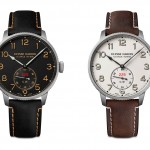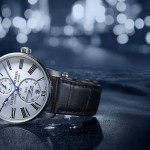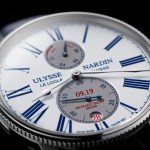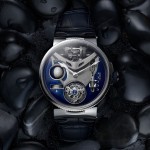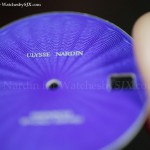Hands-On: Ulysse Nardin Marine Torpilleur 42 mm
A surprising value proposition.
One of the longest-lived models in the Ulysse Nardin line up, the Marine is modelled on vintage marine chronometers, the precision clocks in gimballed boxes found on ships of old. Originally introduced in 1996 as the Marine Chronometer 1846, the watch was one of the brand’s signature models during the tenure of former owner Rolf Schnyder, a larger than life entrepreneur who made Ulysse Nardin (UN) a presence in contemporary watchmaking.
Several generations later, the design is now found on an entry-level model that is surprisingly accomplished despite being quite affordable, the Marine Torpilleur 42 mm. (NB: The version pictured here is in rose gold and naturally costs more; the steel model is priced under US$7,000.)
Initial thoughts
The Marine Torpilleur is an interesting proposition because it’s a fairly thin sports, or at least sporty, watch that has an obviously classical design that still manages to be functional. It manages that because the design is based the marine chronometer, a classical yet functional instrument.
And the Marine Torpilleur is powered by the excellent, in-house UN-118 movement, while being priced at a little under US$7,000 in steel. That sets it apart from most watches in the same price segment, because the Marine Torpilleur has a competent dial and case, but an excellent movement. So from a technical perspective, it is a strong value-buy.

The watch is largish but slim, with a dial that’s essentially a replica of a marine chronometer dial, and a 50 mm water-resistance rating. The result is pretty much the opposite of the typical modern-day sports watch – sporty but low key. Conversely, the weakness of the watch is very much its strength – the design is classical, but for some it will be plain.
That said, the Marine Torpilleur is offered in other guises: metallic blue or grey dials that are definitely more lively, or the Military edition, which looks, well, more military.
The face
UN was a leading producer of marine chronometers – a clock mounted on a gimbal to keep it level regardless of a ship’s motion – in the late 19th and early 20th century, giving it a legitimate claim to the marine chronometer dial design.
The design is admittedly a generic one – all marine chronometers looked alike, more or less – but sensible and effective. It’s characterised by the power reserve indicator at 12 o’clock, an oversized seconds just below, and also a date window that manages to be unobtrusive.
Though classical in style, especially with the tall Roman numerals and spade hands, the dial is functional and easily legible. The only downside is the lack of luminous paint on the dial, which means it cannot be read in darkness.


UN was founded in 1846
This particular variant in rose gold has a white dial with an eggshell texture, giving it the most retro look. The other variants with grey or blue dials have a radial brushed finish that is slightly more lively. Regardless of colour, the dials are all simple but well executed enough. That said, none of the dials capture the slightly rough but eminently functional look of the brass dials found on vintage marine chronometers, which would have been a nice touch.
And UN debuted a limited-edition version with a fired enamel dial last year that’s the most appealing, though it costs about 20% more.
Proportions
Measuring 42 mm by 11 mm, the Marine Torpilleur has the wide-but-thin proportions that give it a slightly more refined profile. A bowl-shaped case middle that slopes inwards towards the back also helps, while giving it a smaller footprint than the bezel diameter.


Like the dial, the case finished neatly and simply, with the narrowly-knurled bezel being the only fancy element. The design works, and it wears well.
Unlike preceding generations of marine chronometer models that had integrated lugs, and an integrated strap was stiff and sometimes clunky, the Marine Torpilleur has conventional lugs that take an ordinary strap, making it easier to wear.

The serial number is engraved on a plate screwed onto the side of the case, a hallmark of the brand since it was taken over by Rolf Schnyder
In-house
Of all the elements that make up the watch, the movement is the most elaborate, which is a surprise given the price point.
A large calibre that fills the case nicely, the UN-118 is an in-house automatic that’s found in many of the brand’s watches. In both aesthetics and technical features, the UN-118 is superior to the common ETA 2892, and also better than most in-house movements in comparably priced watches.

Equipped with a 22k gold rotor cast in relief and decorated competently, the UN-118 one of the best looking movements in price range. Although the decoration is no doubt done by machine – as it is for nearly all watches at this price point – it is well done and attractive. All of the details are attended to, leaving nothing looking unfinished or inadequate.

The notably attractive rotor is done in UN’s traditional style, with twin anchors and the logo filled with blue lacquer


And the UN-118 is also technically proficient, boasting features like a free-sprung balance under a full balance bridge, while the hairspring, escape wheel, and pallet lever are all silicon.

The balance wheel is held in place by a full bridge, which offers more stability than the more common balance cock

The rotor has four adjustable masses for regulation, and is attached to a silicon hairspring
The UN-118 also has a useful 60-hour power reserve, and is would by a “Magic Lever”mechanism. Though the Magic Lever occupies quite a bit of real estate, it is liked for its robustness and simplicity. The winding mechanism is revealed through the barrel bridge, sitting just beside the axis of the rotor.

Concluding thoughts
The Marine Torpilleur sets itself apart from the competitive in a substantive, technical manner – with the UN-118 – and for that reason is a value proposition. Admittedly the design is classical, and not exciting in any way, but it is a solid look that doesn’t try too hard.
Key facts and price
Ulysse Nardin Marine Torpilleur 42 mm
Ref. 1182-310/40 (stainless steel)
Ref. 1182-310/40 (18k rose gold)
Case diameter: 42 mm
Case height: 11 mm
Material: Steel of 18k rose gold
Water resistance: 50 m
Movement: UN-118
Features: Hours, minutes, seconds; date and power reserve display
Frequency: 28,800 beats per hour (4 Hz)
Winding: Automatic
Power reserve: 60 hours
Strap: Alligator or rubber, as well as bracelet in steel mesh or link
Availability: From Ulysse Nardin boutiques and retailers
Price: US$6,900 in steel on strap; US$7,600 in steel on bracelet; US$17,900 in rose gold on strap
For more, visit Ulysse-nardin.com.
Back to top.

